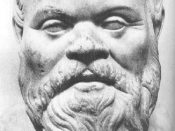The Argument from Design, and the Problem of Evil
The teleological argument, better known as the argument from design, is one of the well-known arguments for the existence of God. It has arisen out of man's amazement at the intricacy and complex layout of many features of the natural world. Take, for example, the ability of honeybees to create honeycombs using the minimum amount of wax for the maximum amount of storage. This is possible by using the hexagon shape rather than any other as the structure. Even more awe-inspiring is the fact that the bees start from different locations, often working in two or three separate groups, yet still each hexagon is identical. When the separate teams of bees reach the middle, and weave the last hexagon in place, there is no sign of a junction or imperfection - humans presented with the same task would find it practically impossible to mirror this feat without the aid of external technology (Yahya 2001:191).
It is details in nature like these that bring man to wonder at its complexity, and may bring him to the conclusion that there is no plausible explanation other than that of a designer and creator, who in this example 'inspired' the bees with the knowledge or 'instinct' to weave their honeycomb with such accuracy.
William Paley presents his own interpretation of this argument in Feinberg and Shafer-Landau. He imagines walking across a heath, and on his journey coming across a stone. It would be rational to assume that this stone had always been there. He then carries on walking to find a watch. The same explanation cannot be given for the watch, as unlike the stone, the watch carries out a specific function. It is composed of complex workings and finery, which could not have...


